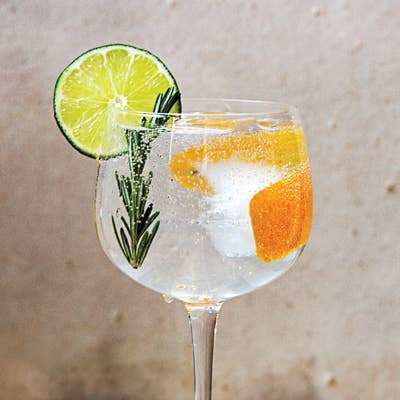
A world of new gin styles and a rising interest in artisan and homemade tonic waters and syrups mean the classic gin and tonic is undergoing a sort of renaissance. This former staple of a drink—light, basic, satisfying—has blossomed into something complex, celebratory, and sometimes even loud. We've rounded up our favorite gin and tonic variations.
The classic gin and tonic is beautiful on its own, but a little color doesn't hurt. Our ultimate gin and tonic is dressed up with citrus wheels, juniper berries, lemon verbena leaf, and edible flowers.
One of the most interesting ways to spice up a gin and tonic is to make your own tonic. The Conquistador is a Spanish-inspired drink with a tonic flavored with lemon and grapefruit juice, fennel seeds, cinchona bark powder (for tonic’s trademark quinine bitterness), and star anise. For the Queen Victoria, the tonic is flavored with raspberry-flavored orris root and peppery, flowery grains of paradise. Making your own tonic takes a little work, but it’s fairly easy and extremely rewarding.
If you don't want to make your own tonic, there are plenty of other ways to modify G&T. The Pretty Tony is a standard gin and tonic with the addition of ten drops of Angostura bitters, which add a delicious spice. If you'd prefer something fruitier try the Plymouth gin tonic, made with fresh strawberries and just a pinch of black pepper.
You're sure to find a G&T variation to your liking in our collection of gin and tonic recipes.
Los Gintonic
Vermouth adds character to this Stateside riff on the elaborate Spanish-style gin tonic, while a tonic water flavored with bitter lemon balances the aromatized wine’s sweetness. Navy-strength gin stands up to them both. Get the recipe for Los Gintonic »
Plymouth Gin Tonic
Sweet-tart strawberries and spicy peppercorns make for a fruity twist on the classic gin and tonic. Get the recipe for Plymouth Gin Tonic »
Hierba Gin and Tonic
At Spanish-born chef José Andrés’ U.S. restaurants, including the Washington, D.C.– and Las Vegas–based tapas bars called Jaleo, at least ten different variations on the gin and tonic are served. One of our favorites is this pretty version that’s dressed with whole pink peppercorns, citrus, and rosemary. A dry gin lets the aromatic garnishes shine. Get the recipe for Hierba Gin and Tonic »
Quick Like a Bunny
Playing on the classic gin and tonic, bartender Stuart Jensen of Denver’s Mercantile restaurant adds caraway-flavored aquavit and marmalade to this green version. Get the recipe for Quick Like a Bunny »
Queen Victoria Tonic
This highball uses a homemade tonic infused with raspberry-flavored orris root and peppery, flowery grains of paradise to complement the specific flavor profile of Bombay Sapphire gin.
Mother-of-Pearl
Brisk and aromatic, celery flavors this savory gin and tonic variation in three ways: in a salt rim, in the bitters, and in the garnish. A fennel frond adds an extra layer of perfume to the drink. Get the recipe for Mother-of-Pearl »
Bar Code Tonic
Tonic water derives its bitterness from quinine, a purified substance derived from the bark of the cinchona tree. Paired with gin, tonic water makes for one of summer’s most refreshing cocktails. At Bar Code in Bellevue, Washington, the gin and tonic is made in a unique manner: The gin itself is infused with cinchona bark, citrus, and other aromatics. Then, rather than tonic, soda water is added to make the drink.
The Pretty Tony
With a drink as clear and straightforward as a traditional gin and tonic, the addition of bitters can transform the appearance, flavor, and aroma in delightful ways. Here, 10 dashes of Angostura bitters add bright spice to a version from Wingtip in San Francisco.
Nuestra Casa
The classic gin and tonic gets a seasonal twist from a splash of pear and allspice liqueurs.
Keep Reading
Continue to Next Story










